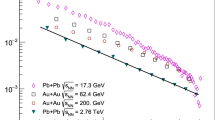Abstract
The evaluation of the number of ways we can distribute energy among a collection of particles in a system is important in many branches of modern science. In particular, in multiparticle production processes the measurements of particle yields and kinematic distributions are essential for characterizing their global properties and to develop an understanding of the mechanism for particle production. We demonstrate that energy distributions are connected with multiplicity distributions by their generating functions.

Similar content being viewed by others
Data Availability Statement
This manuscript has no associated data or the data will not be deposited. [Authors’ comment: The work presented here is theoretical and all the required formulas are given in the article. All data generated or analysed during this study are included in this published article.]
Notes
For an updated bibliography on this subject, see http://tsallis.cat.cbpf.br/biblio.htm.
Similarly as \(N^{th}\) derivatives of G(z) taken at \(z=0\) define multiplicity distribution P(N), the respective derivatives taken at \(z=1\) define factorial moments \({\mathcal {F}}_{N}\). Derivatives of \(\ln (G(z))\) taken at \(z=0\) and \(z=1\) define combinants \({\mathcal {C}}_{N}\) and cumulant factorial moments \({\mathcal {K}}_{N}\), respectively.
Actually this is the method of generating Poisson distribution in the numerical Monte Carlo codes.
References
D. Van Dantzig, Colloques internationaux du CNRS 13, 29–45 (1949)
J.T. Runnenburg, On the use of collective marks in queueing theory, in Congestion theory, ed. by W.L. Smith, W.E. Wilkinson (University of North Carolina Press, Chapel Hill, 1965), pp. 399–438
L. Kleinrock, Queueing systems, Chapter 7, vol. 1 (Wiley, New York, 1975)
Y. Zhang, M. Hlynka, P.H. Brill, arXiv:1908.04370v1 [math.PR]
C. Tsallis, J. Statist. Phys. 52, 479 (1988). https://doi.org/10.1007/BF01016429
C. Tsallis, Eur. Phys. J. A 40, 257 (2009a). https://doi.org/10.1140/epja/i2009-10799-0. [arXiv:0812.4370 [physics.data-an]]
C. Tsallis, Introduction to nonextensive statistical mechanics (Springer, Berlin, 2009)
G. Wilk, Z. Włodarczyk, Acta Phys. Polon. B 46(6), 1103 (2015). https://doi.org/10.5506/APhysPolB.46.1103. [arXiv:1501.01936 [cond-mat.stat-mech]]
C. Michael, L. Vanryckeghem, J. Phys. G 3, L151 (1977). https://doi.org/10.1088/0305-4616/3/8/002
C. Michael, Prog. Part. Nucl. Phys. 2, 1 (1979). https://doi.org/10.1016/0146-6410(79)90002-4
G. Arnison et al., UA1 collaboration. Phys. Lett. 118B, 167 (1982). https://doi.org/10.1016/0370-2693(82)90623-2
R. Hagedorn, Riv. Nuovo Cim. 6N10, 1 (1983). https://doi.org/10.1007/BF02740917
C.Y. Wong, G. Wilk, L.J.L. Cirto, C. Tsallis, Phys. Rev. D 91(11), 114027 (2015). https://doi.org/10.1103/PhysRevD.91.114027. [arXiv:1505.02022 [hep-ph]]
G. Wilk, Z. Wlodarczyk, Eur. Phys. J. A 48, 161 (2012). https://doi.org/10.1140/epja/i2012-12161-y. [arXiv:1203.4452 [hep-ph]]
W. Feller, An introduction to probability theory and its applications, vol. II (Wiley, New York, 1966)
W. Broniowski, A. Olszewski, Phys. Rev. C 95(6), 064910 (2017). https://doi.org/10.1103/PhysRevC.95.064910. [arXiv:1704.01532 [nucl-th]]
G. Wilk, Z. Wlodarczyk, Phys. A 376, 279 (2007). https://doi.org/10.1016/j.physa.2006.10.042
Author information
Authors and Affiliations
Corresponding author
Additional information
Communicated by Ulf Meissner.
Appendix A: Boltzmann-Gibbs energy distribution and Poissonian multiplicity distribution
Appendix A: Boltzmann-Gibbs energy distribution and Poissonian multiplicity distribution
Suppose that one has N independently produced particles with energies \(\{E_{1,\ldots ,N}\}\), distributed according to Boltzmann distribution,
with “temperature” parameter \(T=\langle E\rangle \). The sum of energies, \(U=\sum _{i=1}^{N}E_{i}\) is then distributed according to gamma distribution
with cumulative distribution equal to:
Looking for such N that \(\sum _{i=0}^{N}E_{i}\le U\le \sum _{i=0}^{N+1}E_{i}\) we find its distribution. which has known Poissonian form
with \(\langle N\rangle =U/T\).
For the constrained systems (if the available energy is limited, \(U=\mathrm{const}\)), whenever we have independent variables \(\{E_{1,\ldots ,N}\}\) taken from the exponential distribution (A.1), the corresponding multiplicity N has Poissonian distribution (A.4)Footnote 4. However, if the multiplicity is limited, \(N=\mathrm{const}\), the resulting conditional probability becomes:
the same as given by Eq. (5), and only in the limit \(N\rightarrow \infty \) the energy distribution goes to the Boltzmann distribution (A.1). For fluctuating multiplicity according to Poisson distribution, the energy distribution is given by (A.1).
In the same way, as demonstrated in Ref. [17], Tsallis energy distribution is connected with the NBD of multiplicity.
Rights and permissions
About this article
Cite this article
Rybczyński, M., Włodarczyk, Z. Correspondence of multiplicity and energy distributions. Eur. Phys. J. A 57, 3 (2021). https://doi.org/10.1140/epja/s10050-020-00315-5
Received:
Accepted:
Published:
DOI: https://doi.org/10.1140/epja/s10050-020-00315-5



